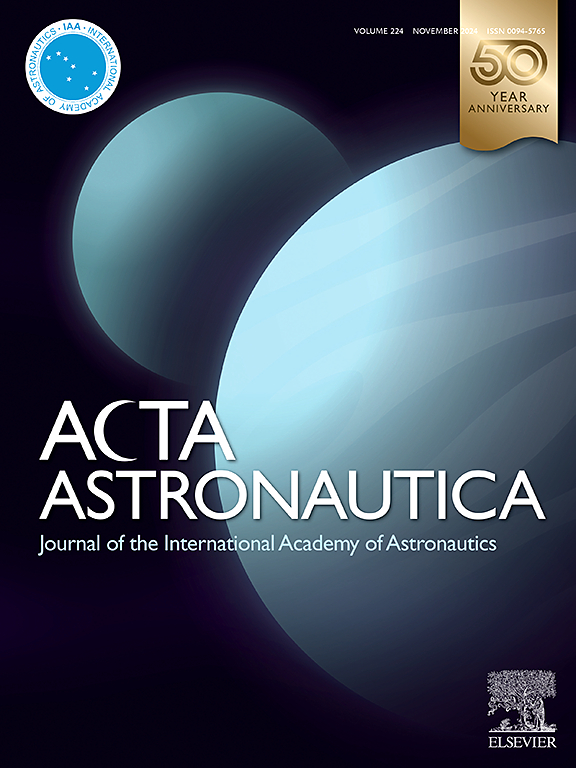Effect of input power on plasma expansion and ion acceleration in a radio-frequency plasma thruster
IF 3.1
2区 物理与天体物理
Q1 ENGINEERING, AEROSPACE
引用次数: 0
Abstract
Exploring the physics of low pressure plasmas expanding in a diverging magnetic nozzle, and the resulting acceleration mechanisms, plays an important role in the development of a new-type of electrode-less plasma propulsion systems. This study discusses the effects of input power on plasma expansion and ion beam acceleration in a magnetic nozzle electrode-less plasma thruster. The experiments were conducted in a radio-frequency magnetic nozzle plasma device at The University of Auckland with four different power configurations . Different plasma diagnostics were used to measure the characteristics of the plasma plume. A planar Langmuir probe was used to measure the floating potential and ion saturation current both in the plasma source and in the expansion chamber. The potential drop in the plasma source was obtained with an emissive probe. A retarding field energy analyser was employed to evaluate the local plasma and ion beam potentials, the ion energy distribution functions, and to estimate the ion beam speed in the expansion region. Measurements showed that, as expected, increasing the power input resulted in a higher plasma and supersonic ion density, while the ion beam speed did not increase further for W. Interestingly, and contrary to the idealised physical model, the ion sonic transition did not occur at the magnetic nozzle throat, but instead close to the geometrical expansion point, i.e. near the interface between the source tube and the expansion chamber. This feature would result in a lower performance of the thruster given the reduced expansion ratio. An E-H mode change is also observed to occur in the device with increasing radio-frequency power that would help explain the different plasma characteristics observed at the 200 W transition point.
输入功率对射频等离子推进器中等离子膨胀和离子加速度的影响
探索低压等离子体在发散磁性喷嘴中膨胀的物理学原理以及由此产生的加速机制,对于开发新型无电极等离子体推进系统具有重要作用。本研究讨论了输入功率对磁性喷嘴无电极等离子体推进器中等离子体膨胀和离子束加速的影响。实验在奥克兰大学的射频磁性喷嘴等离子装置中进行,采用了四种不同的功率配置 PRF。使用了不同的等离子体诊断技术来测量等离子体羽流的特性。使用平面朗缪尔探针测量等离子源和膨胀腔中的浮动电势和离子饱和电流。等离子体源中的电位降是通过发射探针获得的。使用阻滞场能量分析仪评估了局部等离子体和离子束电位、离子能量分布函数,并估算了膨胀区域的离子束速度。测量结果表明,正如预期的那样,增加输入功率会导致更高的等离子体和超音速离子密度,而在 PRF>100 W 时,离子束速度并没有进一步增加。有趣的是,与理想化物理模型相反,离子声速转换并没有发生在磁性喷嘴喉部,而是发生在几何膨胀点附近,即源管和膨胀腔之间的界面附近。由于膨胀比降低,这一特征将导致推进器性能降低。还观察到随着射频功率的增加,装置中出现了 E-H 模式变化,这有助于解释在 200 W 过渡点观察到的不同等离子体特性。
本文章由计算机程序翻译,如有差异,请以英文原文为准。
求助全文
约1分钟内获得全文
求助全文
来源期刊

Acta Astronautica
工程技术-工程:宇航
CiteScore
7.20
自引率
22.90%
发文量
599
审稿时长
53 days
期刊介绍:
Acta Astronautica is sponsored by the International Academy of Astronautics. Content is based on original contributions in all fields of basic, engineering, life and social space sciences and of space technology related to:
The peaceful scientific exploration of space,
Its exploitation for human welfare and progress,
Conception, design, development and operation of space-borne and Earth-based systems,
In addition to regular issues, the journal publishes selected proceedings of the annual International Astronautical Congress (IAC), transactions of the IAA and special issues on topics of current interest, such as microgravity, space station technology, geostationary orbits, and space economics. Other subject areas include satellite technology, space transportation and communications, space energy, power and propulsion, astrodynamics, extraterrestrial intelligence and Earth observations.
 求助内容:
求助内容: 应助结果提醒方式:
应助结果提醒方式:


